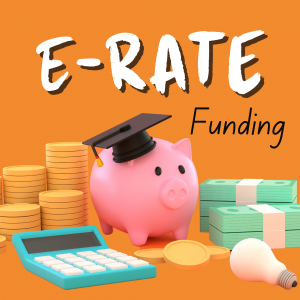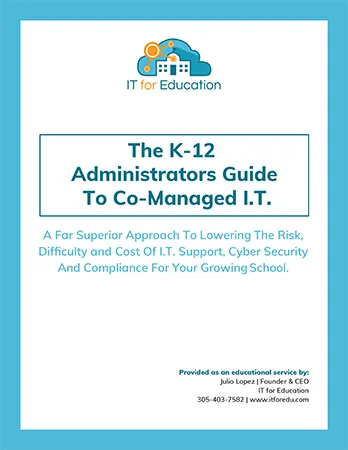 As the Emergency Connectivity Fund (EFC) and Elementary and Secondary School Emergency Relief (ESSER) funds close, schools must focus on the Federal Communications Commission's E-rate Discount Program for technology budget support. While the ECF and ESSER funds aided many schools, they also presented challenges for administrators preparing for a modern learning environment. Schools strategically transitioning from ECF and ESSER funding will have a better chance of taking advantage of their e-rate discount opportunities. K-12 administrators and IT decision-makers must be aware of the following information regarding the E-rate program:
As the Emergency Connectivity Fund (EFC) and Elementary and Secondary School Emergency Relief (ESSER) funds close, schools must focus on the Federal Communications Commission's E-rate Discount Program for technology budget support. While the ECF and ESSER funds aided many schools, they also presented challenges for administrators preparing for a modern learning environment. Schools strategically transitioning from ECF and ESSER funding will have a better chance of taking advantage of their e-rate discount opportunities. K-12 administrators and IT decision-makers must be aware of the following information regarding the E-rate program:
What is E-Rate?
E-Rate, short for Education Rate, is a federal program in the United States established to provide discounts on telecommunications and internet services to eligible schools and libraries. The program, initiated under the Telecommunications Act of 1996, aims to ensure that educational institutions have affordable access to the Internet, fostering a conducive environment for learning and research. The program is managed by the Universal Service Administrative Corp. (USAC), which has been designated by the Federal Communications Commission (FCC).
What are the criteria for eligibility?
Before delving into the nitty-gritty of E-Rate, it's vital to understand whether your school or library qualifies for this program. Eligibility is determined based on the following criteria:
- School Type
E-Rate primarily targets K–12 public and private schools and public libraries. Higher education institutions, including colleges and universities, have separate funding mechanisms and are not covered under this program.
- Free and Reduced Lunch Program
One of the critical determinants of eligibility is whether a significant portion of the student body qualifies for the National School Lunch Program. Schools where at least 20% of students are eligible for free or reduced-price lunches are more likely to qualify for E-Rate discounts.
- Rural or Urban Location
The program prefers schools and libraries in rural areas, as these areas often face more significant challenges in securing affordable broadband services.
- Compliance with FCC Rules
Schools and libraries must comply with the FCC rules and regulations to participate in E-Rate. This includes adhering to the Children's Internet Protection Act (CIPA) requirements, which mandate student internet safety measures.
What are the categories for E-Rate funding?
E-Rate provides discounts in two main categories:
- Category 1: Telecommunications Services
Covers the costs associated with internet access and data transmission services. This includes the fees for broadband internet connections and wide area network (WAN) services.
- Category 2:Internal Connections
Supports internal networking and Wi-Fi infrastructure within schools and libraries. This encompasses installing and maintaining routers, switches, and wireless access points.
How is the application process?
To take advantage of E-Rate discounts, K–12 administrators must navigate the application process, which typically follows these steps:
- Form 470: Schools issue a Form 470, requesting bids from service providers for eligible services. This form notifies potential vendors of the school's requirements.
- Evaluation of Bids: Schools evaluate the bids received and select the most cost-effective service provider.
- Form 471: After choosing a service provider, schools submit Form 471, which outlines the requested services and the preferred vendor. IT for Education is a USAC-approved E-rate provider of Category 2 services; SPIN is 143052324. We have helped countless schools access these federal subsidies to integrate fast and expansive Wi-Fi access and other improvements to their network infrastructure.
- Review and Approval: The Universal Service Administrative Company (USAC), responsible for administering E-Rate, reviews and approves eligible applications.
- Funding Commitment: Once approved, schools receive a funding commitment from USAC, indicating the discount percentage they will receive. Download our calculator here to get an estimate of your school funding budget.
- Invoice and Payment: Schools submit invoices to USAC to reimburse the approved discounts after delivering services.
What is the importance of the E-rate program after ECF and ESSER initiatives?
Schools have utilized ECF and ESSER funding to equip students with laptops and expand internet connectivity beyond campus using hotspots and other methods. However, with numerous devices belonging to students and teachers, all requiring network access, the challenge for schools is unique. Administrators have been devising plans to utilize E-rate's five-year budget cycle to facilitate upgrades and updates that support the surge in on-campus devices.
In an era where digital literacy and connectivity are paramount, E-Rate has emerged as a lifeline for K–12 educational institutions. It ensures that students can access the digital resources necessary for a well-rounded education, irrespective of their socio-economic backgrounds. By understanding the program's intricacies and eligibility criteria, schools and libraries can make informed decisions to leverage E-Rate and enhance the educational experience for all students.
It's time to take the next step towards success. Schedule a Discovery Call with one of our experts today and embark on a journey of innovation and growth.
During this call, you'll have the opportunity to:
- Discuss your unique challenges and goals.
- Gain insights and recommendations from our experienced professionals.
- Explore how our tailored solutions can drive tangible results for your school.
Take advantage of this chance to collaborate with our experts and chart a path to success. Let's turn your vision into reality.



